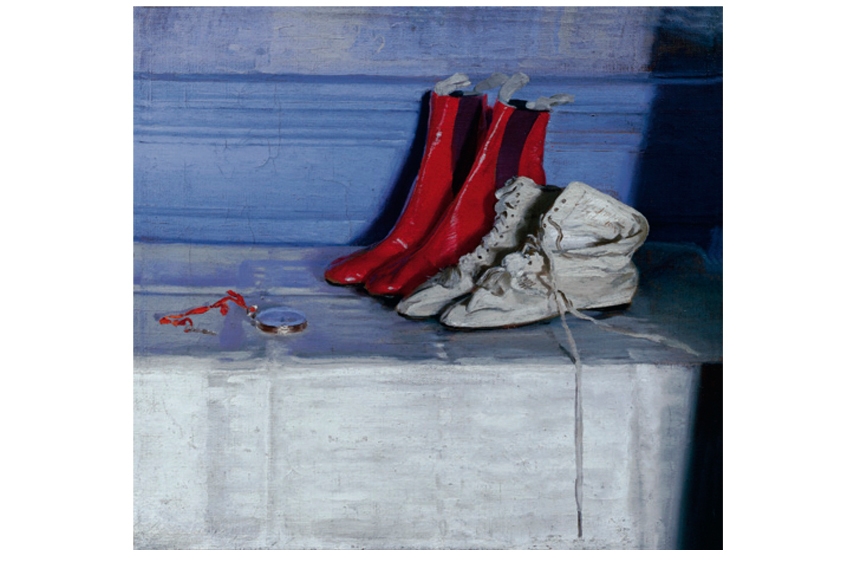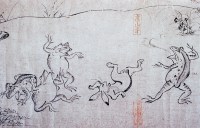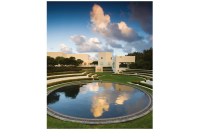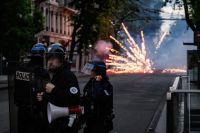A pleasingly tactile canvas-like cover adorns this heavy book and proclaims its purpose; the boldly brushed illustration is a detail from ‘Mauve Primulas on a Table’ painted in January 1928 when the artist was in his mid-fifties. He wrote of a ‘painting orgy’ and how he suffered ‘tennis-elbow from holding my brush for 8 hours solid’. Patricia Reed’s catalogue note adds, ‘the work is a synthesis of the motifs that interested him at this moment: a tilted picture plane, textured cloth, penumbrated shadows, a cropped bowl and a pair of open scissors’. It is pertinent to follow with a quote from Merlin James’s introductory essay on Nicholson’s ‘Painting and Experience’, that ‘the simpler his images appear, the more complex and ambiguous they turn out to be’, and this applies to his portraits and landscapes as well as to the still lifes.
William Nicholson, or WN as he is throughout the catalogue, was born in Newark-on-Trent in 1872. His father made agricultural machinery and became an MP, but right from the start WN was single-mindedly and independently an artist. In the 1890s he set painting aside to work on woodcuts and illustrations — being the W of J and W Beggarstaff with James Pryde, his brother-in-law — but by his 30th birthday he was a painter again.
‘His life’, Wendy Baron writes in her contextual essay, ‘had filled out in all its dimensions. He had a wife and three children. His woodcut of Queen Victoria at once achieved, to use an overworked phrase, iconic status’. His portfolios of hand-coloured woodcuts including ‘An Alphabet’ with his self-portrait for A was an Artist, were published to great acclaim, and ‘his social life included friendships and artistic collaborations with many of the defining characters of the decade’. The century does not turn more poignantly than with the diminutive Queen-Empress robed in black, in contrast to the action portraits of the natural aristocrat (though a labourer) Edward Russell of the Eynsham Morris, with his red ribbons flying.
Patricia Reed has organised her Catalogue Raisonné — and the painter’s life — chronologically, with sensibility and precision. For ‘two decades or more’ she has searched out the paintings (and gives intriguing notes on the lost, stolen or strayed), and they are beautifully reproduced. Portraits take precedence, followed by the landscapes, particularly of the painter’s beloved Sussex and Wiltshire downland (with a seasoning of Continental views) and then the still lifes, ‘sensational yet self-effacing triumphs’ with reflections and flowers.
Nicholson paints where he loves — his children, his mistresses, his friends; he is a connoisseur of women with interesting faces and of informality — the Churchills’ ‘Breakfast at Chartwell’, ‘Lord and Lady Wardington at Tea’, and the aged Beatrice and Sidney Webb by their fireside. He also paints his 20th century — Sir William Beveridge, the physicist Sir William Bragg, soldiers, solicitors, a mining engineer, an oil baron, war-weary London and the Cenotaph.
One of the defining friendships of his life was with the architect Edwin Lutyens, who commissioned a portrait of his gardening friend Gertrude Jekyll, though WN had to paint her boots whilst waiting for the lady herself. Lutyens and WN went to India and it was rather characteristic of their shared disdain for authority that the portrait of the Viceroy, Lord Hardinge (whom he did not like) is considerably outshone by the splendid white-clad figure of Duffadur Valayar Shah, the Viceroy’s Orderly.
Lutyens and WN were friends for 40 years, the friendship at its closest when they were neighbours in Apple Tree Yard, the mews north of St James’s Square: they shared connections to Rottingdean, to Folly Farm and Mells Manor, to South Africa and Sir Lionel and Lady Phillips (WN’s second marriage was to their daughter Edie), to Lutyens’s daughter Ursula Ridley and her family, to Pamela McKenna and her children, and to Frederick Muntzer, the interior decorator of Dover Street, Piccadilly.
This capacious and glorious volume completes the William Nicholson oeuvre with The Graphic Work by Colin Campbell (1992), and Sanford Schwartz’s biography of 2004, the same year as the catalogue for the Royal Academy exhibition, The Art of William Nicholson, compiled by the quartet of Campbell, James, Reed and Schwartz.







Comments
Comments will appear under your real name unless you enter a display name in your account area. Further information can be found in our terms of use.